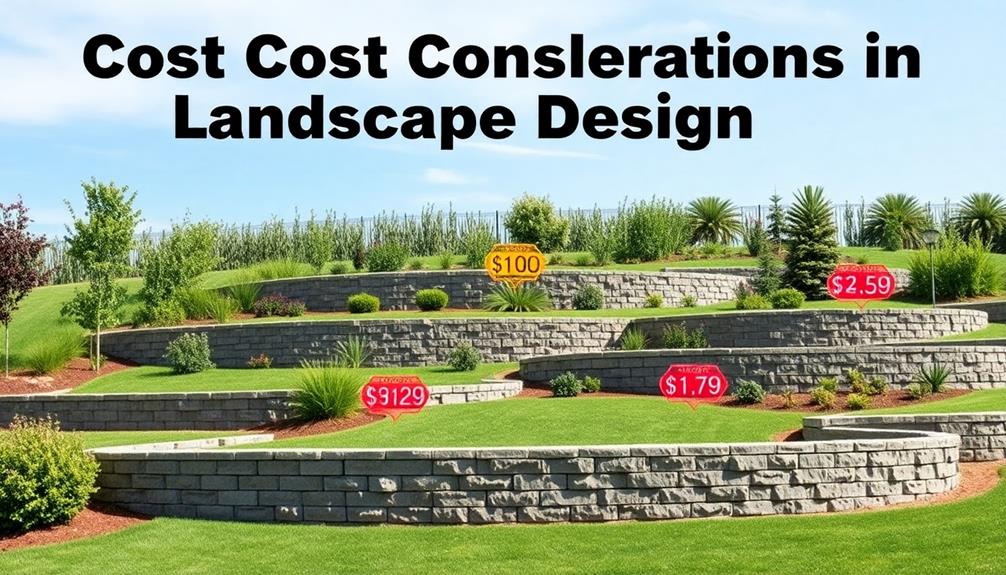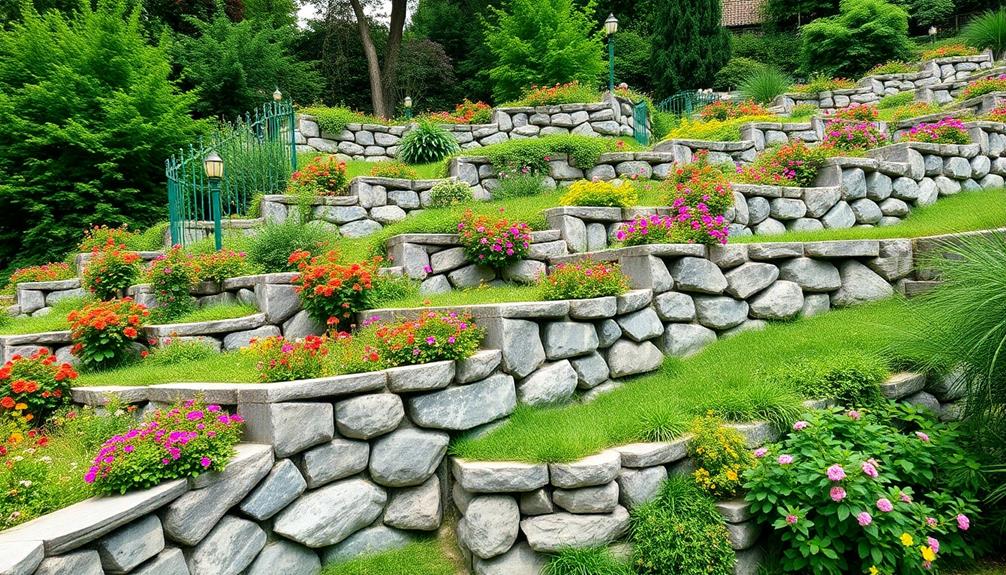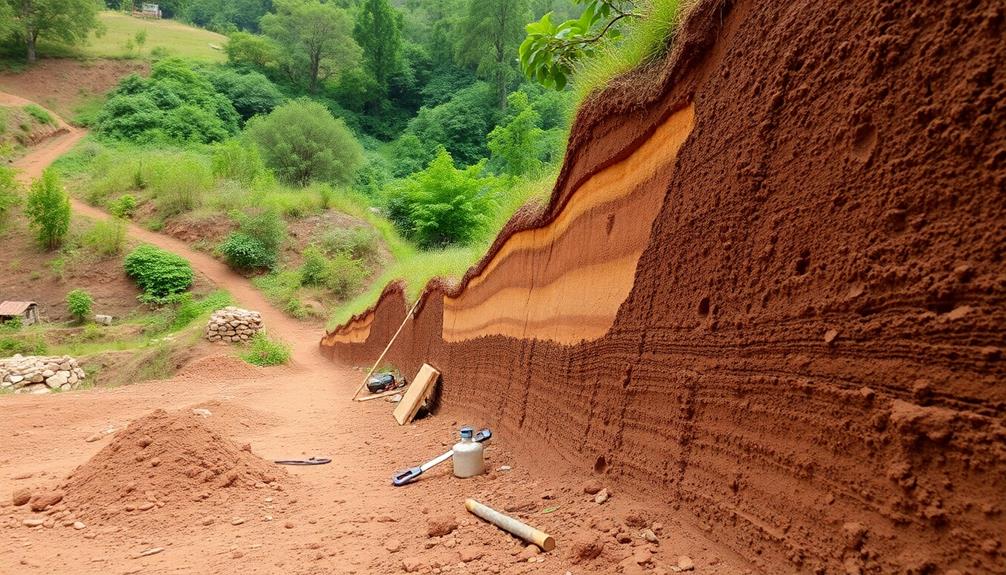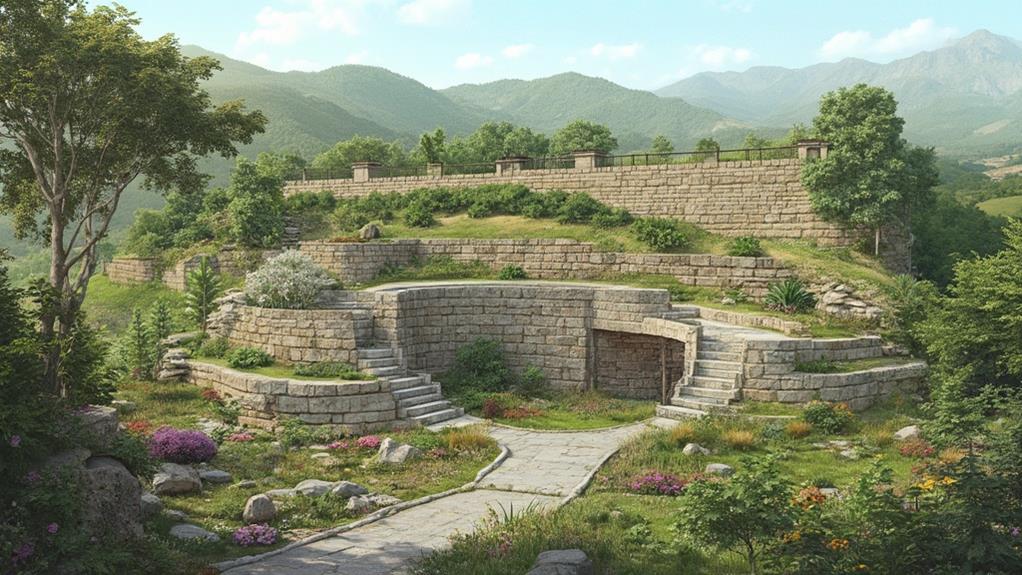Understanding retaining wall costs is crucial due to its significant role in effective budget planning and the long-term financial health of construction projects. Retaining walls require substantial capital investment, impacting property stability, aesthetic enhancements, and strategic long-term planning. Meticulous cost analysis aids in selecting appropriate materials, managing labor expenditures, and ensuring compliance with necessary codes and regulations. Additionally, employing cost-saving strategies, such as choosing cost-effective materials and optimizing designs, enhances fiscal responsibility while safeguarding structural integrity. By grasping these cost dynamics, stakeholders can align resources effectively and make informed decisions, securing a well-managed project that aligns with shared objectives and future goals.
Table of Contents
ToggleWalls Contractor Highlights
- Comprehensive understanding of costs enables effective budget planning and informed decision-making for retaining wall projects.
- Consideration of retaining wall expenses ensures long-term financial strategies and property stability are maintained.
- Analyzing cost details helps stakeholders allocate resources efficiently and align project timelines.
- Strategic cost-saving measures can reduce initial expenses while preserving wall integrity and performance.
- Knowledge of costs and long-term value assures investment in durable materials and expert craftsmanship.
Cost Importance Explained

Understanding the costs associated with retaining walls is essential for effective budget planning, as these structures can represent significant capital investments that impact long-term financial strategies.
Companies like Boulder Walls, which have established expertise and resources, guarantee all walls meet building code requirements. Recognizing the long-term value they add to property stability and aesthetics underscores their role as a prudent investment.
Additionally, strategic cost-saving measures, such as selecting the appropriate materials and optimizing design efficiencies, can mitigate expenses while safeguarding structural integrity and performance.
Budget Planning Essentials
In the domain of construction projects, budget planning stands as a pivotal component, particularly for structures like retaining walls. Comprehending the intricate details of cost allows stakeholders to make informed decisions that guarantee the project adheres to financial constraints while maintaining structural integrity.
Incorporating budget planning essentials into the early stages of a project forms a foundation that aligns expectations, resource allocation, and timeline considerations with the project's financial blueprint.
To effectively manage a budget for retaining walls, consider the following essential elements:
- Material Selection: Understanding the cost variance among materials such as concrete, stone, or wood is critical for balancing aesthetics and functionality with financial limitations.
- Labor Costs: Allocation for skilled labor should reflect region-specific wage standards and the complexity of the project, ensuring equitable compensation and project quality.
- Site Preparation: Recognizing site-specific factors, such as terrain stability and accessibility, influences preparation costs and is paramount to preventing unforeseen expenses.
Navigating these components fosters a sense of unity among project participants, instilling confidence that the undertaking will proceed smoothly and within budgetary confines. Emphasizing detailed cost analysis and strategic foresight in budget planning weaves the disparate elements of a project into a cohesive whole, guaranteeing fiscal responsibility and shared objectives.
Long-Term Investment Value
How often do we consider the enduring value of a well-constructed retaining wall when planning a project? Beyond mere functionality, a retaining wall epitomizes a lasting investment, offering both structural integrity and enhanced property value. By investing in durable materials and expert craftsmanship, a retaining wall can withstand adverse environmental conditions over time. This resilience reduces the frequency of repairs and replacements, which ultimately translates into significant long-term savings.
For a community that prides itself on orderly neighborhoods and cohesive landscapes, the aesthetic appeal of a retaining wall cannot be underestimated. A meticulously designed wall not only manages soil and water runoff but also enhances the beauty and uniformity of outdoor spaces. Homeowners and developers alike find solace in knowing they've chosen an element that harmonizes with the surroundings while promising sustained reliability.
Furthermore, investing in quality construction fosters a sense of pride and security within a community, knowing the infrastructure is built to last. This assurance strengthens the sense of belonging, as individuals feel a connection to a space where strategic decisions reflect collective wisdom and foresight. Ultimately, the long-term value of retaining walls lies in their ability to gracefully marry form, function, and future-proof stability.
Cost-Saving Strategies
While the long-term investment benefits of retaining walls are substantial, initial outlays can be a considerable consideration for homeowners and developers. To address these costs without compromising quality or functionality, several cost-saving strategies can be employed, ensuring the project aligns with financial constraints while still delivering expected utility and aesthetic appeal.
By meticulously planning and implementing thoughtful measures, you can realize notable savings during the construction phase.
Key strategies include:
- Material Selection: Opt for durable yet cost-effective materials such as timber or interlocking concrete blocks, which provide strength without the high costs associated with natural stones.
- Design Optimization: Simplify the design to reduce unnecessary complexities that can escalate expenses. Streamlined designs can capitalize on efficient use of materials and labor.
- DIY Involvement: Engage in pre-construction activities you can manage yourself, like preparing the site or managing simple installations, to cut labor costs considerably.
Pooling resources and experiences with fellow community members can further enhance the efficacy of these strategies, fostering a collective approach to reducing expenses. Understanding and applying these methods empowers homeowners and developers alike to create not only a lasting structural benefit but also a sense of shared achievement and community value.
Benefits

Investing in retaining walls not only contributes extensively to increased property value and enhanced landscape aesthetics but also offers indispensable benefits in erosion control and structural stability. These structures serve as a reliable defense against soil displacement, which can otherwise lead to costly damage and unsightly land degradation.
Furthermore, boulder retaining walls also make a powerful statement with their sheer size and natural allure, adding a unique and attractive feature to any property. Additionally, a well-designed retaining wall can transform uneven terrain into usable space, providing practical and aesthetic benefits that align with both residential and commercial property improvement goals.
Increased Property Value
The addition of a retaining wall can drastically enhance the overall value of a property. By fortifying land against erosion, a retaining wall not only secures the physical stability of a plot but also profoundly elevates its market appeal. This enhancement in property value derives from several beneficial attributes a retaining wall introduces, aligning effortlessly with community expectations of quality and endurance.
Structural Integrity: A well-built retaining wall guarantees safety and stability, protecting the property from the detrimental effects of soil erosion and water runoff.
Functional Space: Terracing can transform unusable slopes into functional areas, offering new opportunities for landscaping or outdoor amenities, which prospective buyers often value.
Low Maintenance: A durable retaining wall can reduce future upkeep costs by managing drainage effectively and preventing land degradation, appealing to buyers seeking long-term solutions.
Properties featuring retaining walls are often perceived as more enticing to potential buyers due to these intrinsic advantages. By mitigating the risks associated with landscape instability and maximizing usable space, retaining walls can substantially contribute to the perceived and actual value of a real estate investment. This investment facilitates not just practical benefits but also fosters a sense of belonging among community-driven buyers who appreciate enduring quality.
Improved Landscape Aesthetics
Enhancing the visual appeal of a property, retaining walls play a critical role in improving landscape aesthetics. These structures offer more than mere functionality; they introduce a pleasing harmony and organization to outdoor spaces. Through careful selection of materials and colors, retaining walls can complement existing architectural styles, thereby unifying disparate elements within the property.
Their versatility in design allows for various decorative techniques, such as terracing, which transforms flat, unremarkable lands into visually dynamic landscapes. By creating distinct outdoor areas, retaining walls can support the growth of plantings, fostering green spaces that further enrich curb appeal.
In addition to their immediate visual impact, retaining walls serve as enduring investments for homeowners who take pride in meticulous landscape design. They offer an opportunity for individual expression, enabling property owners to infuse personal style into their surroundings. Additionally, when executed with attention to detail, retaining walls elevate residential spaces, adding layers of depth that invite exploration and enjoyment.
The resulting environments, grounded in well-thought-out landscaping decisions, engender a sense of belonging for those residing in and visiting the property. Consequently, investing in retaining walls is not simply about cost—it's a commitment to cultivating inviting landscapes that resonate with beauty and inclusivity.
Erosion Control Benefits
When addressing erosion concerns, retaining walls provide substantial environmental benefits by stabilizing soil and preventing its displacement. In the quest to maintain the integrity of your land, these structures serve as a steadfast ally, mitigating the detrimental impact of water runoff and soil erosion. By integrating retaining walls into your landscape, you protect the ecosystem and promote sustainability. Understanding the efficacy of retaining walls in controlling erosion necessitates an in-depth examination into their specific advantages.
Soil retention: Retaining walls hold back soil in sloped areas, preventing erosion by maintaining soil structure and minimizing the loss of precious topsoil.
Water management: These walls effectively manage water drainage by directing runoff appropriately, reducing the risk of water pooling and soil erosion.
Slope management: By supporting steep terrains, retaining walls prevent landslides, ensuring terrain stability and protecting nearby infrastructures and habitats.
Incorporating retaining walls not only benefits the immediate landscape but extends its protective reach to downstream environments, reducing sediment flow and preserving water quality. As members of a conscientious community, investing in retaining walls represents a commitment to stewardship, securing the well-being of shared natural resources for present and future generations. Understanding these costs isn't just about financial planning—it's about investing in a sustainable future.
Structural Stability Enhancement
Recognizing the erosion control benefits of retaining walls naturally leads to an appreciation of their role in enhancing structural stability. A well-constructed retaining wall does more than manage soil displacement and prevent erosion; it fortifies landscapes against the stresses induced by gravity and environmental forces. For homeowners and developers, understanding this structural benefit means ensuring safety and longevity for constructions built on sloped or uneven terrain.
Retaining walls are integral to maintaining the integrity of built environments, providing a robust countermeasure against soil movement that could undermine building foundations or infrastructure. The stability they offer is not merely a byproduct of their presence but a calculated design, involving considerations of material strength, wall height, and appropriate drainage solutions. Such elements are critical, as they work in tandem to bolster the reliability of the landscape.
In community developments, these structures create safer, more resilient spaces that withstand the test of time and the elements. This assurance emboldens community members with confidence, knowing that their investments in property and infrastructure are safeguarded. Ultimately, the understanding of retaining wall costs reflects an investment in the security and stability of shared environments.
Soil Stability Concerns

When addressing soil stability concerns in retaining wall projects, it is vital to methodically assess soil composition, evaluate slope stability, and identify drainage challenges, as each factor drastically impacts the wall's structural integrity and overall cost deliberations. Ensuring the right approach involves a detailed evaluation of soil characteristics such as type, density, and cohesion, alongside a thorough analysis of the slope to predict potential shifts or collapses. The table below outlines these critical points to ponder:
| Aspect | Factors to Evaluate | Importance |
|---|---|---|
| Soil Composition | Type, Density, Cohesion | Determines load-bearing capacity |
| Slope Stability | Angle, Vegetation | Influences potential movement |
| Drainage Challenges | Water Flow, Soil Saturation | Affects wall durability |
Assessing Soil Composition
Understanding the intricacies of soil composition is paramount when evaluating soil stability concerns for retaining wall projects. A thorough assessment of soil properties provides a foundation for informed decision-making, ensuring the structural integrity and longevity of retaining walls, which form essential components of our communities. Soil analysis is not merely a preliminary step but a critical process that influences both material selection and construction strategies.
In the context of retaining wall projects, identifying the soil's characteristics can determine its capacity to support loads and resist lateral pressures. Key factors in this assessment include:
- Soil Type: Recognizing whether the soil is clay, silt, or sand helps predict its behavior under pressure.
- Moisture Content: Evaluating water levels identifies possible expansion, contraction, and potential instability.
- Density and Compaction: Understanding how densely packed the soil is can impact the necessary depth and design of foundations.
Evaluating Slope Stability
Evaluating slope stability is a critical consideration in the planning and construction of retaining walls, as it directly impacts the safety and durability of the structure. When designing a retaining wall, understanding the characteristics of the slope, including its angle, height, and underlying geological conditions, is essential to prevent catastrophic failures. This assessment helps professionals determine the most appropriate wall design, height, and material to use, ensuring the wall remains stable over time.
A detailed geological survey is often a first step, revealing the soil's bearing capacity and potential movement under various conditions. Topographical data and soil samples provide insights into the potential for erosion or landslides, which can compromise structural integrity. Engineers may use sophisticated software and modeling techniques to simulate scenarios, testing how the slope might behave during heavy rainfall or seismic activity.
The knowledge gathered through this evaluation fosters a sense of security and belonging for those depending on these structures. Incorporating this data into the design process minimizes risks, guiding the selection of reinforcement strategies such as geogrid, soil nails, or anchors. By addressing slope stability proactively, communities can build confidence in their infrastructure, knowing it is designed to withstand changing environments.
Identifying Drainage Challenges
In developing robust retaining wall systems, slope stability must be assessed not only for geological features but also in conjunction with effective drainage solutions to address soil instability. Properly identifying drainage challenges is paramount to guarantee the long-term durability of retaining structures, as inadequate drainage can exacerbate erosion and compromise soil integrity. Retaining walls, when constructed without sufficient consideration of water management, may become undermined by water pressure buildup or unexpected water flow patterns within the system.
Key drainage challenges often encountered include:
- Water Accumulation: Without proper channels or outlets, water can collect behind the wall, increasing lateral pressure and potentially leading to structural failure.
- Erosion Risk: Persistent water infiltration can lead to soil displacement leading to destabilization of the wall footing, reducing overall wall efficacy.
- Soil Saturation: Excess moisture in the soil can lead to reduced friction in particulate material, increasing the likelihood of slippage or wall displacement.
For a thriving, united community of developers and stakeholders, understanding these challenges fosters informed decisions and cultivates bonds built on shared expertise. By addressing drainage needs earnestly, projects not only succeed but sustain a shared vision of enduring and reliable infrastructure.
Walls Contractor FAQ
What Are the Common Materials Used in Building Retaining Walls?
Common materials used in building retaining walls include concrete blocks, poured concrete, stone, brick, and timber. Each material offers distinct aesthetic and functional benefits, enabling communities to create landscapes that resonate harmoniously with their environment and preferences.
How Do Local Building Codes Impact Retaining Wall Construction?
Local building codes greatly influence retaining wall construction by dictating design standards, height limitations, and material specifications, thereby ensuring safety and structural integrity. Adhering to these codes fosters community trust and promotes harmonious residential and commercial developments.
What Is the Typical Lifespan of a Well-Built Retaining Wall?
The typical lifespan of a well-constructed retaining wall ranges from 50 to 100 years, contingent upon materials used, environmental factors, and routine maintenance. Investing in quality construction guarantees/safeguards the structure remains a reliable and lasting asset.
How Do Environmental Factors Affect Retaining Wall Durability?
Environmental factors, such as soil composition, weather conditions, and drainage systems, greatly influence the durability of retaining walls. Addressing these elements effectively guarantees a reliable structure, fostering a sense of security and stability within the community.
What Are the Initial Steps for Planning a Retaining Wall Project?
To plan a retaining wall project, assess site conditions, determine the desired wall function, and consult with experts. Engaging with professionals guarantees compliance with regulations and enhances project success, fostering a sense of community and shared achievement.







